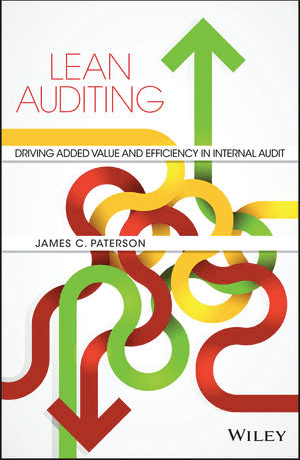
This is the second in a three-part article on Lean Auditing by by James C. Paterson, Director of Risk & Assurance Insights, Ltd. In part one, Mr. Paterson briefed detailed the principles behind lean. Here, he provides a number of examples of using the methodology to improve audit work.
Add your thoughts in the comment section and be automatically entered to win one of four free copies of James C. Paterson’s book.
By James Paterson
Read part one of this article here.
More lean techniques to achieve these principles in practice are contained in the book, but here are some of the practical applications and consequences of lean ways of working to internal auditing:
Being clear who are the key customers of our audit work
As one head of audit explained to me:
“When I first started out in audit, I was more interested in the value I added to the business managers I was auditing. One, it’s an easier life, you keep people happy who you are dealing with 95% of the time, but over time I see it’s a mistake to forget that you’ve got competing interests in terms of what other stakeholders might want”.
Lean principles give us insights into how we might balance different stakeholder needs and – perhaps surprisingly – also provides some interesting insights in relation to the ways internal auditors can tackle questions around maintain their independence and objectivity.
Being clear what those customers really want (and what they do not want).
When considering the audit report one head of audit I interviewed explained:
“A report is only valuable when management and the board use it and see that it helps them.
If they briefly look at it and then put it aside, then it is basically useless … On the other hand, if they look at the report and say ‘yes, this is something I think will help me manage my business’ or if they discuss the contents of the report with other parts of the business, then it is a good sign.
My measurement of the value of an audit report is not about the contents or the number of issues raised but by how management and the board use it to manage their business.”
Another key area lean helps us to pay attention to is the ways in which audit work can create dissatisfaction in management, and take proactive steps to manage this.
Pay close attention to identifying Muda (waste)
A key founder of lean ways or working, Shingo Shigeo, said: “The most dangerous waste is the waste we do not recognize”. This explains the “first principles” approach to lean that goes far beyond simple benchmarking.
The following examples illustrate some of the ways in which a lean approach can benefit and audit team.
Resource assignments appropriately:
One head of audit explained:
“We are being more flexible but also more challenging on the amount of time we spend on assignments. We will accept a more diverse range of how much time we will spend, the aim being to more closely match assignment lengths to the likely value add.”
Typically a lean auditing approach will reduce the budgeted number of days that are custom and practice in the audit team and speed up the delivery timelines planned.
Plan assignments carefully
One interviewee explained:
“Planning an assignment is key because when I see things going wrong, including delays in delivery, it is often because we didn’t think enough up front. It can be as simple as not recognizing a key contact is travelling or on holiday for 2 weeks during the assignment.
Unless people have really thought about what they want and sufficiently planned and been rigorous in engaging the business, problems will arise”.
Beyond this is the question of the proper role for internal audit in terms of how to handle issues that have already been identified by management; after all it adds little value to be told by management that an audit report is largely telling them what they already know!
Another interviewee explained:
“Good audit departments put a lot of effort into thinking about and agreeing the scope of their audits so they are addressing important points; and as a result key findings will then be meaningful to the organization”.
. . . .
In the last part of this article, Mr. Paterson will provide additional examples of and observations on using lean in carrying out assignments.
Don’t forget to leave a comment to be entered into our Lean Auditing book giveaway. The contest will close and the winners announced the third week in November.

